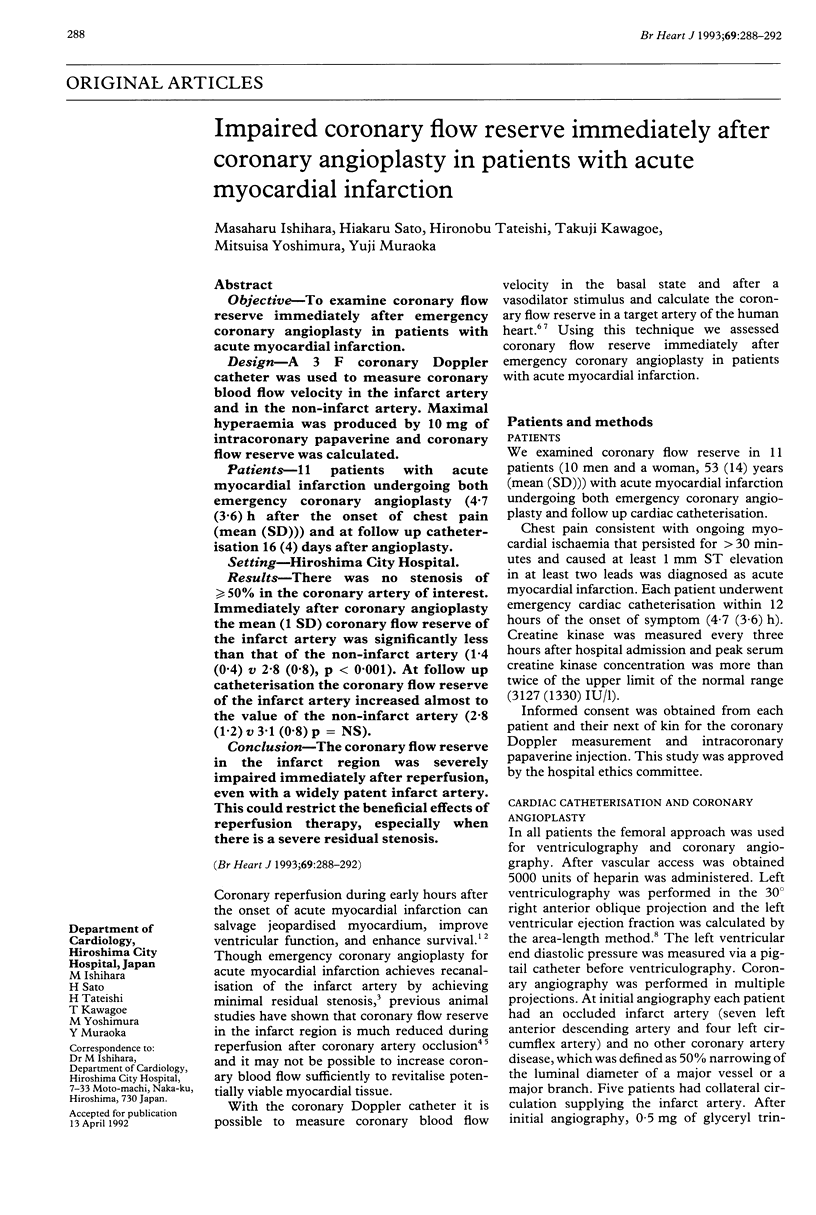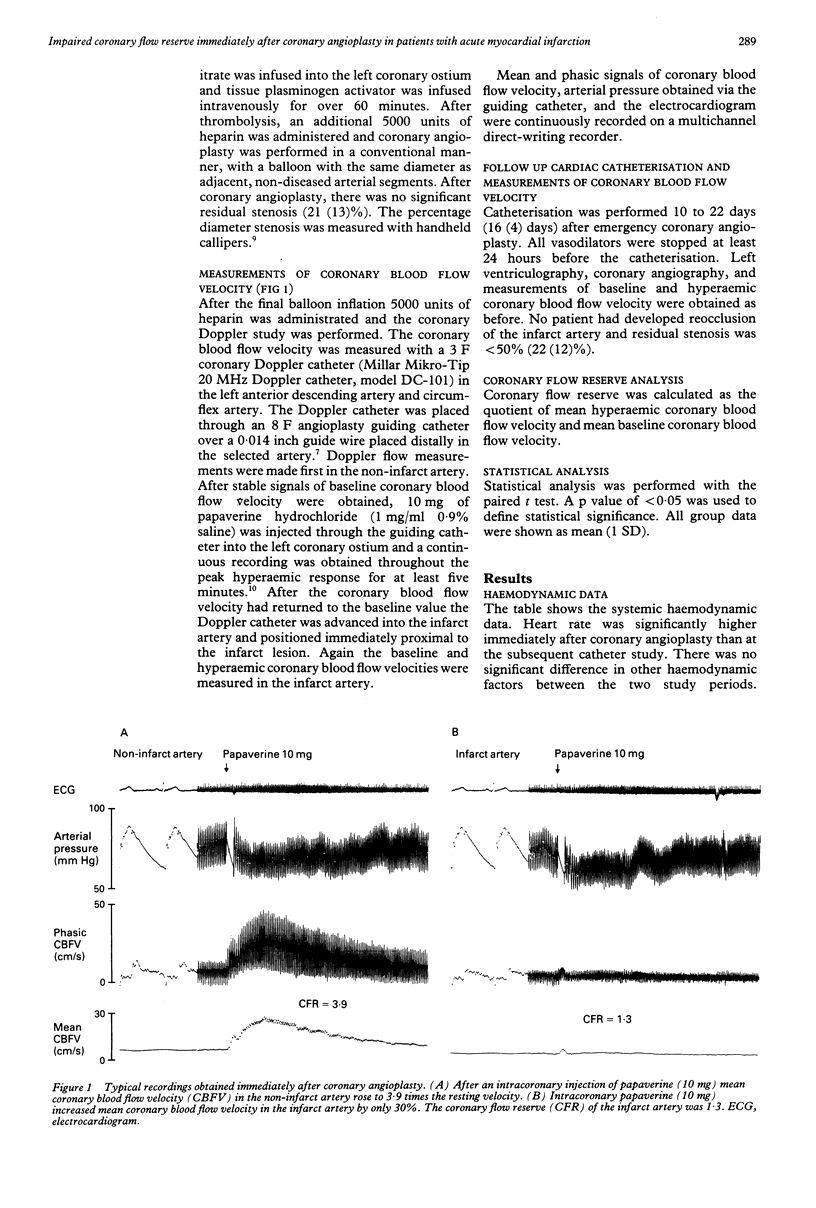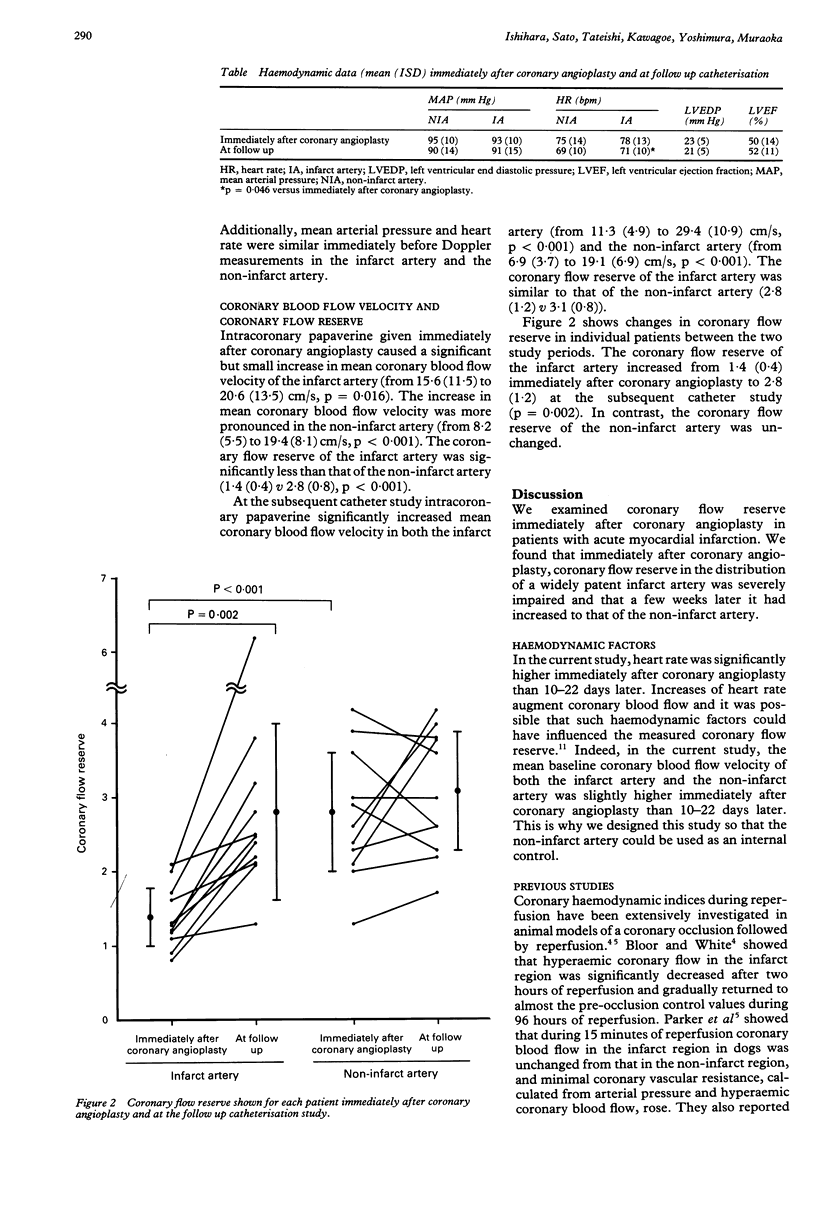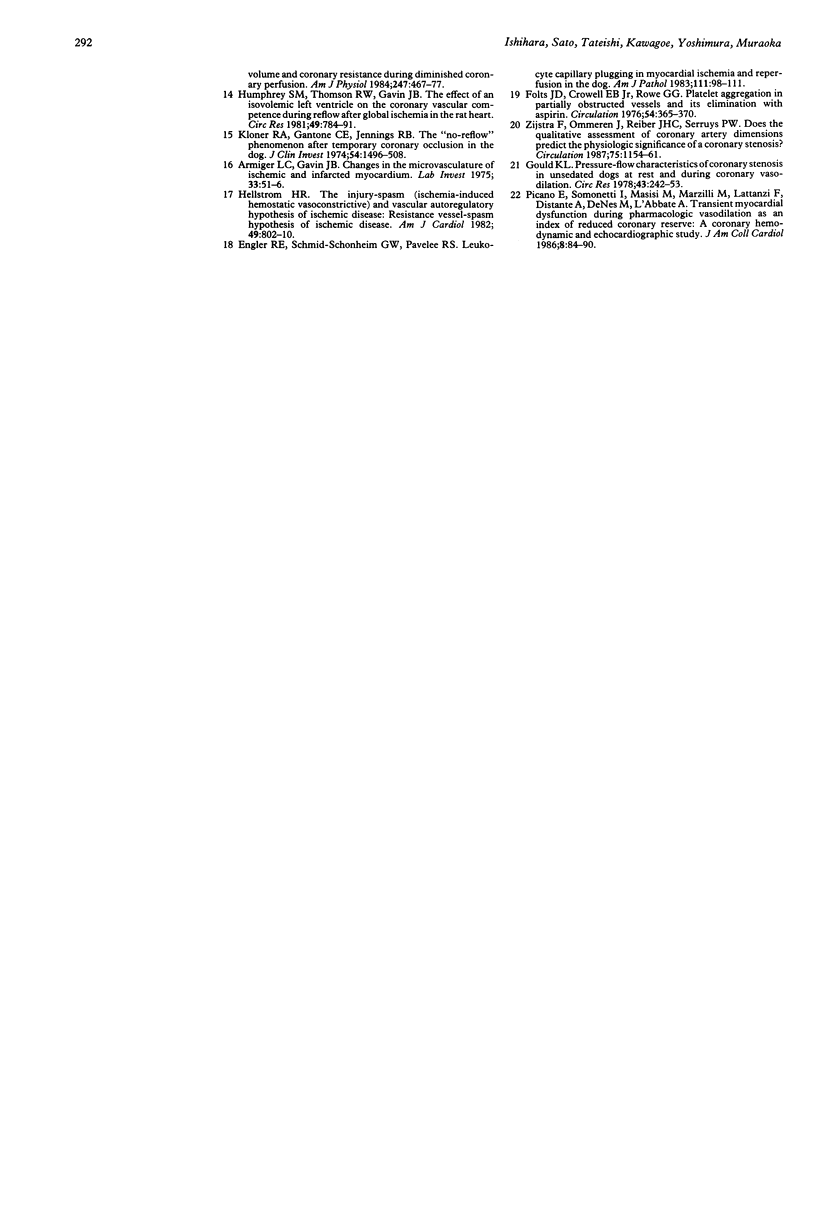Abstract
OBJECTIVE--To examine coronary flow reserve immediately after emergency coronary angioplasty in patients with acute myocardial infarction. DESIGN--A 3 F coronary Doppler catheter was used to measure coronary blood flow velocity in the infarct artery and in the non-infarct artery. Maximal hyperaemia was produced by 10 mg of intracoronary papaverine and coronary flow reserve was calculated. PATIENTS--11 patients with acute myocardial infarction undergoing both emergency coronary angioplasty (4.7 (3.6) h after the onset of chest pain (mean (SD))) and at follow up catheterisation 16 (4) days after angioplasty. SETTING--Hiroshima City Hospital. RESULTS--There was no stenosis of > or = 50% in the coronary artery of interest. Immediately after coronary angioplasty the mean (1 SD) coronary flow reserve of the infarct artery was significantly less than that of the non-infarct artery (1.4 (0.4) v 2.8 (0.8), p < 0.001). At follow up catheterisation the coronary flow reserve of the infarct artery increased almost to the value of the non-infarct artery (2.8 (1.2) v 3.1 (0.8) p = NS). CONCLUSION--The coronary flow reserve in the infarct region was severely impaired immediately after reperfusion, even with a widely patent infarct artery. This could restrict the beneficial effects of reperfusion therapy, especially when there is a severe residual stenosis.
Full text
PDF




Selected References
These references are in PubMed. This may not be the complete list of references from this article.
- Armiger L. C., Gavin J. B. Changes in the microvasculature of ischemic and infarcted myocardium. Lab Invest. 1975 Jul;33(1):51–56. [PubMed] [Google Scholar]
- Bloor C. M., White F. C. Coronary artery reperfusion: effects of occlusion duration on reactive hyperemia responses. Basic Res Cardiol. 1975 Mar-Apr;70(2):148–158. doi: 10.1007/BF01905616. [DOI] [PubMed] [Google Scholar]
- DODGE H. T., SANDLER H., BALLEW D. W., LORD J. D., Jr The use of biplane angiocardigraphy for the measurement of left ventricular volume in man. Am Heart J. 1960 Nov;60:762–776. doi: 10.1016/0002-8703(60)90359-8. [DOI] [PubMed] [Google Scholar]
- Engler R. L., Schmid-Schönbein G. W., Pavelec R. S. Leukocyte capillary plugging in myocardial ischemia and reperfusion in the dog. Am J Pathol. 1983 Apr;111(1):98–111. [PMC free article] [PubMed] [Google Scholar]
- Folts J. D., Crowell E. B., Jr, Rowe G. G. Platelet aggregation in partially obstructed vessels and its elimination with aspirin. Circulation. 1976 Sep;54(3):365–370. doi: 10.1161/01.cir.54.3.365. [DOI] [PubMed] [Google Scholar]
- Gould K. L. Pressure-flow characteristics of coronary stenoses in unsedated dogs at rest and during coronary vasodilation. Circ Res. 1978 Aug;43(2):242–253. doi: 10.1161/01.res.43.2.242. [DOI] [PubMed] [Google Scholar]
- Hellstrom H. R. The injury-spasm (ischemia-induced hemostatic vasoconstrictive) and vascular autoregulatory hypothesis of ischemic disease. Resistance vessel-spasm hypothesis of ischemic disease. Am J Cardiol. 1982 Mar;49(4):802–810. doi: 10.1016/0002-9149(82)91962-2. [DOI] [PubMed] [Google Scholar]
- Humphrey S. M., Thomson R. W., Gavin J. B. The effect of an isovolumic left ventricle on the coronary vascular competence during reflow after global ischemia in the rat heart. Circ Res. 1981 Sep;49(3):784–791. doi: 10.1161/01.res.49.3.784. [DOI] [PubMed] [Google Scholar]
- Ishihara M., Sato H., Tateishi H., Uchida T., Dote K. Intraaortic balloon pumping as the postangioplasty strategy in acute myocardial infarction. Am Heart J. 1991 Aug;122(2):385–389. doi: 10.1016/0002-8703(91)90990-y. [DOI] [PubMed] [Google Scholar]
- Kloner R. A., Ganote C. E., Jennings R. B. The "no-reflow" phenomenon after temporary coronary occlusion in the dog. J Clin Invest. 1974 Dec;54(6):1496–1508. doi: 10.1172/JCI107898. [DOI] [PMC free article] [PubMed] [Google Scholar]
- Lee L., Bates E. R., Pitt B., Walton J. A., Laufer N., O'Neill W. W. Percutaneous transluminal coronary angioplasty improves survival in acute myocardial infarction complicated by cardiogenic shock. Circulation. 1988 Dec;78(6):1345–1351. doi: 10.1161/01.cir.78.6.1345. [DOI] [PubMed] [Google Scholar]
- McGinn A. L., White C. W., Wilson R. F. Interstudy variability of coronary flow reserve. Influence of heart rate, arterial pressure, and ventricular preload. Circulation. 1990 Apr;81(4):1319–1330. doi: 10.1161/01.cir.81.4.1319. [DOI] [PubMed] [Google Scholar]
- O'Neill W., Timmis G. C., Bourdillon P. D., Lai P., Ganghadarhan V., Walton J., Jr, Ramos R., Laufer N., Gordon S., Schork M. A. A prospective randomized clinical trial of intracoronary streptokinase versus coronary angioplasty for acute myocardial infarction. N Engl J Med. 1986 Mar 27;314(13):812–818. doi: 10.1056/NEJM198603273141303. [DOI] [PubMed] [Google Scholar]
- Parker P. E., Bashour F. A., Downey H. F., Boutros I. S. Coronary reperfusion: effects of vasodilators (papaverine and adenosine). Am Heart J. 1977 Jan;93(1):66–72. doi: 10.1016/s0002-8703(77)80173-7. [DOI] [PubMed] [Google Scholar]
- Parker P. E., Bashour F. A., Downey H. F., Kechejian S. J., Williams A. G. Coronary hemodynamics during reperfusion following acute coronary ligation in dogs. Am Heart J. 1975 Nov;90(5):593–599. doi: 10.1016/0002-8703(75)90223-9. [DOI] [PubMed] [Google Scholar]
- Picano E., Simonetti I., Masini M., Marzilli M., Lattanzi F., Distante A., De Nes M., L'Abbate A. Transient myocardial dysfunction during pharmacologic vasodilation as an index of reduced coronary reserve: a coronary hemodynamic and echocardiographic study. J Am Coll Cardiol. 1986 Jul;8(1):84–90. doi: 10.1016/s0735-1097(86)80095-x. [DOI] [PubMed] [Google Scholar]
- Sheehan F. H., Doerr R., Schmidt W. G., Bolson E. L., Uebis R., von Essen R., Effert S., Dodge H. T. Early recovery of left ventricular function after thrombolytic therapy for acute myocardial infarction: an important determinant of survival. J Am Coll Cardiol. 1988 Aug;12(2):289–300. doi: 10.1016/0735-1097(88)90397-x. [DOI] [PubMed] [Google Scholar]
- Sibley D. H., Millar H. D., Hartley C. J., Whitlow P. L. Subselective measurement of coronary blood flow velocity using a steerable Doppler catheter. J Am Coll Cardiol. 1986 Dec;8(6):1332–1340. doi: 10.1016/s0735-1097(86)80305-9. [DOI] [PubMed] [Google Scholar]
- Wilson R. F., Laughlin D. E., Ackell P. H., Chilian W. M., Holida M. D., Hartley C. J., Armstrong M. L., Marcus M. L., White C. W. Transluminal, subselective measurement of coronary artery blood flow velocity and vasodilator reserve in man. Circulation. 1985 Jul;72(1):82–92. doi: 10.1161/01.cir.72.1.82. [DOI] [PubMed] [Google Scholar]
- Wilson R. F., White C. W. Intracoronary papaverine: an ideal coronary vasodilator for studies of the coronary circulation in conscious humans. Circulation. 1986 Mar;73(3):444–451. doi: 10.1161/01.cir.73.3.444. [DOI] [PubMed] [Google Scholar]
- Zijlstra F., van Ommeren J., Reiber J. H., Serruys P. W. Does the quantitative assessment of coronary artery dimensions predict the physiologic significance of a coronary stenosis? Circulation. 1987 Jun;75(6):1154–1161. doi: 10.1161/01.cir.75.6.1154. [DOI] [PubMed] [Google Scholar]


